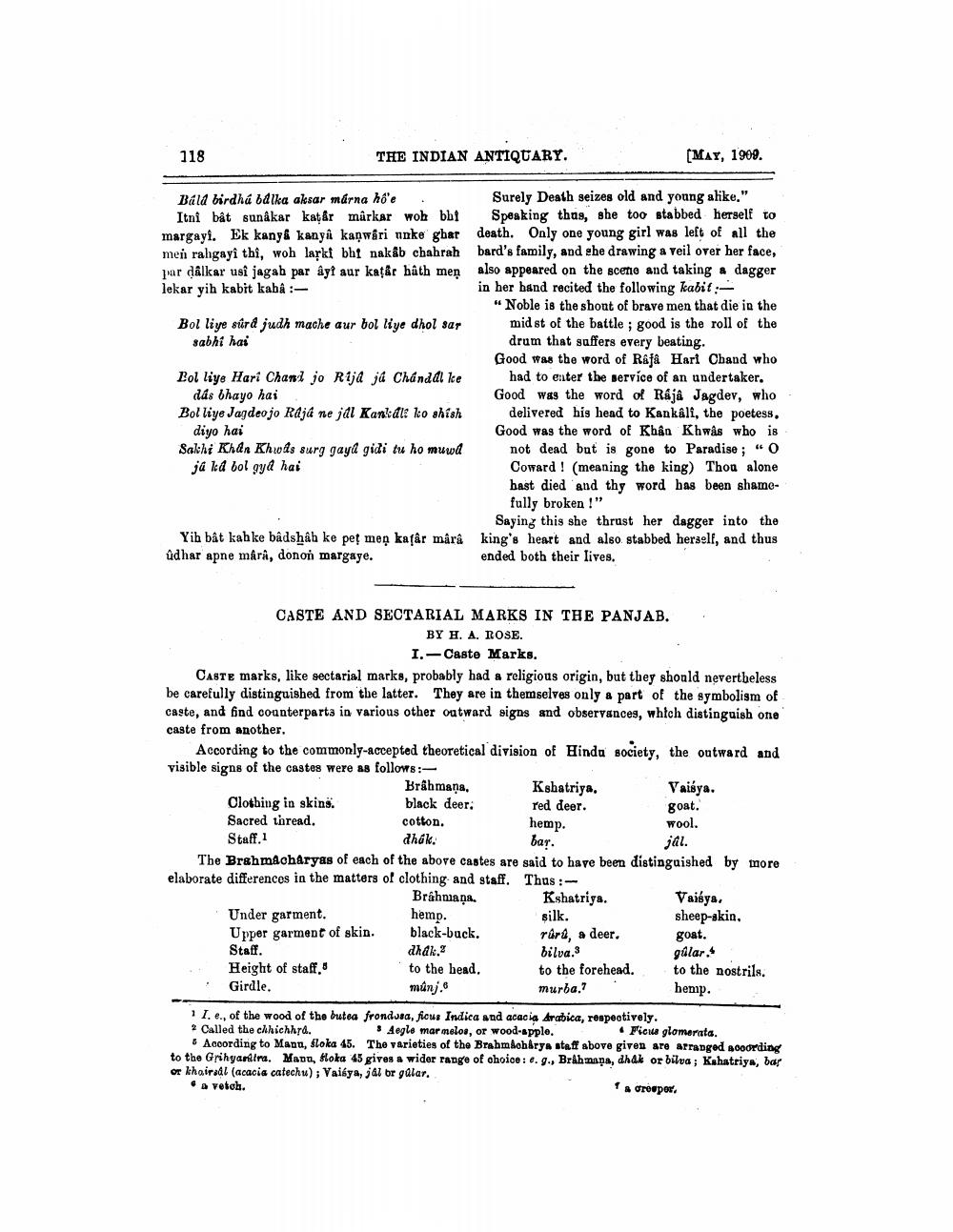________________
118
THE INDIAN ANTIQUARY.
(MAY, 1909.
Bald birdha bdika aksar mårna hoe . Surely Death seizes old and young alike."
Itni båt sunâkar katar markar woh bht Speaking thus, she too stabbed herself to margayi. Ek kanya kanya kanwari unke gbar death. Only one young girl was left of all the men rahgayi thi, woh larki bht nakab chahrah bard's family, and she drawing a veil over her face, jar dålkar usi jagab par ayt aur katar hâth men also appeared on the scene and taking a dagger lekar yih kabit kabâ :
in her band recited the following kabit :
“Noble is the shont of brave men that die in the Bol liye sürd judh mache aur bol liye dhol sar midst of the battle ; good is the roll of the sabhi hai
drum that suffers every beating.
Good was the word of Raja Hari Chand who Bol liye Hari Chanl jo Rija já Chándal ke had to enter the service of an undertaker, dás bhayo hai
Good was the word of Rája Jagdev, who Bol liye Jagdeojo Rajá ne jal Kankale ko shish delivered his head to Kankáli, the poetess, diyo hai
Good was the word of Khân Khwas who is Sakhi Khan Khwis surg gaya gidi tu ho muwd not dead but is gone to Paradise ; “O ja kd bol gya hai
Coward ! (meaning the king) Thou alone bast died and thy word has been shame
fully broken !"
Saying this she thrust her dagger into the Yih båt kah ke bâdshåb ke pet meņ kasår mára king's heart and also stabbed herself, and thus udhar apne mara, donon margaye.
ended both their lives.
CASTE AND SECTARIAL MARKS IN THE PANJAB.
BY H. A. ROSE.
I.- Caste Marks. CASTE marks, like sectarial marks, probably had a religious origin, but they should nevertheless be carefully distinguished from the latter. They are in themselves only a part of the symbolism of caste, and find counterparts in various other outward signs and observances, which distinguish one caste from another.
According to the commonly-accepted theoretical division of Hinda society, the outward and visible signs of the castes were as follows:Brahmana. Kshatriya.
Vaisya. Clothing in skins. black deer, red deer.
goat. Sacred thread.
cotton. hemp.
wool. Staff.1
dhák.
bar. The Brahmacharyas of each of the above castes are said to have been distinguished by more elaborate differences in the matters of clothing and staff. Thus:
Brahmana Kshatriya.
Vaisya. Under garment. hemp.
sheep-skin, Upper garment of skin. black-buck. rüri, a deer. goat. Staff.
dhak. bilva.
gilar. Height of staff.
to the bead. to the forehead. to the nostrils. Girdle.
mûnj.
murba.?
jál.
silk.
bemp.
11. e., of the wood of the butea fronduta, fioue Indica and acacia Arabica, respectively. Called the chhichhrd. Aegle mar nelos, or wood-apple.
Pricia glomerata. • According to Manu, sloka 45. The varieties of the Brabmachbry staff above given are arranged according to the Grihyanina. Mann, Hoka 45 gives a wider range of choice : 6.9., Brahmapa, dhak or bilva; Kshatriya, bar or khairadi (acacia catechu); Vaibya, jal br galar. . votoh.
1. Croopor.




